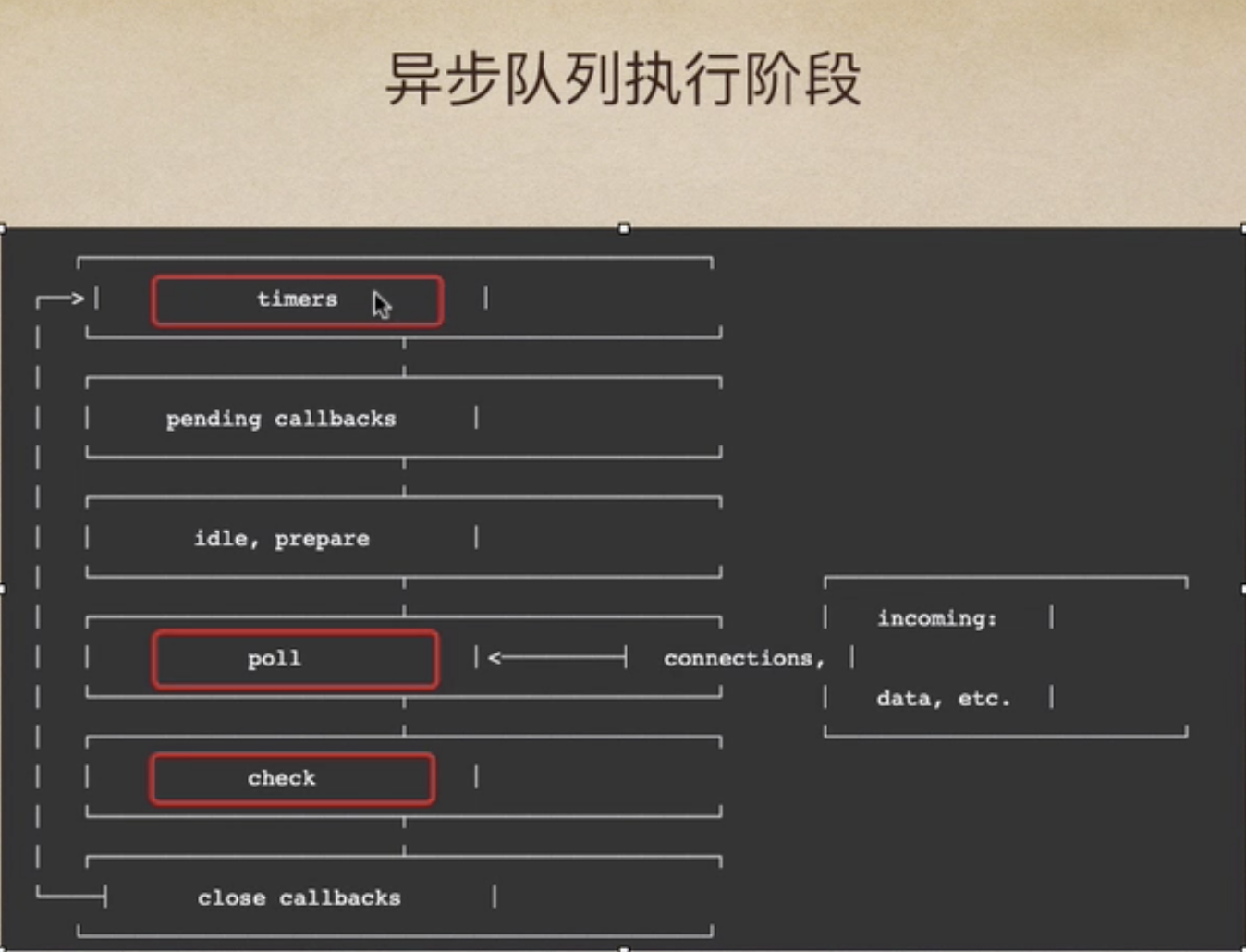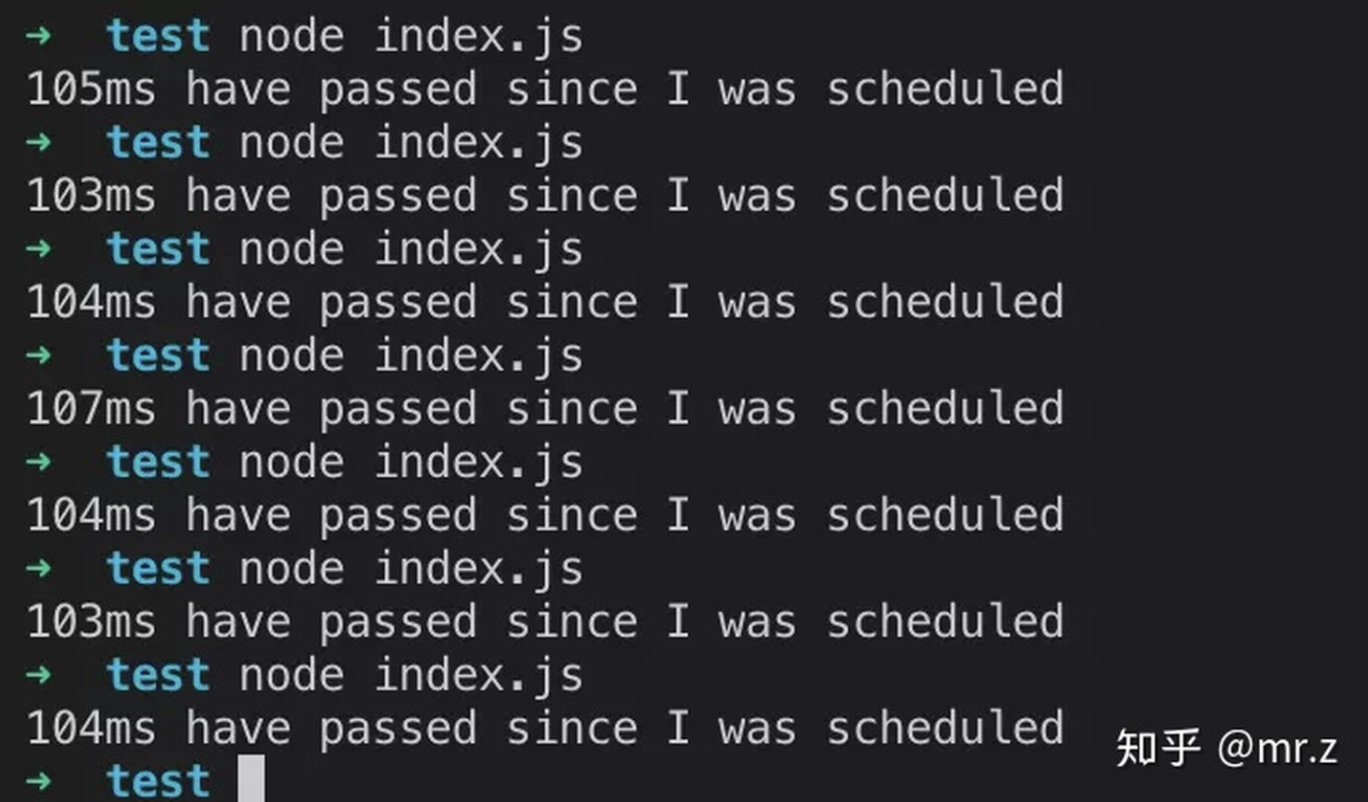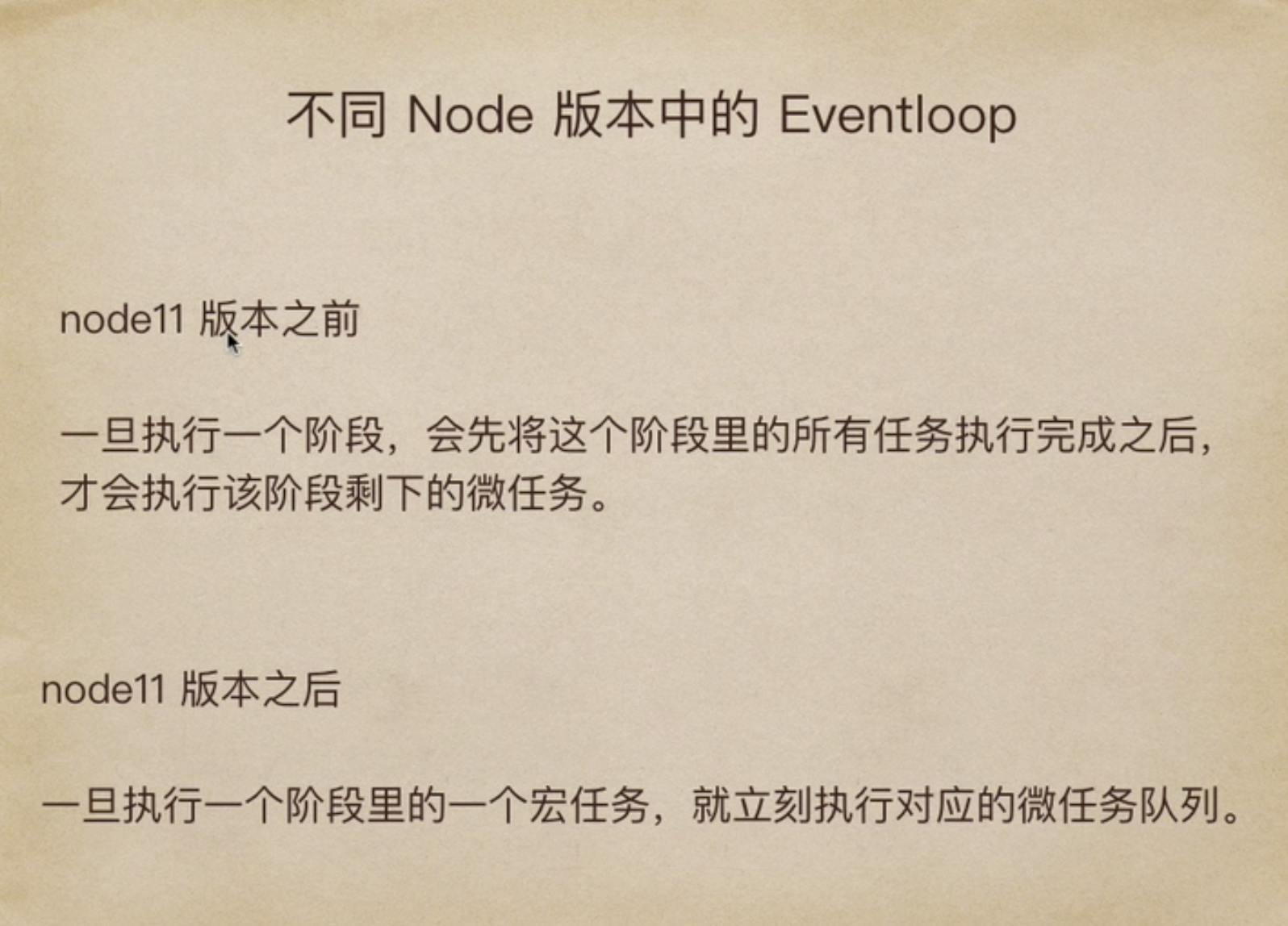# Event Loop 总结
# 前言
Event Loop即事件循环机制,是指浏览器或 Node 的一种解决javaScript 单线程运行不会阻塞的一种机制,也就是我们经常使用异步的原理。
# 浏览器的 Event Loop

由上图我们可以看出Javascript有一个 main thread 主线程和 call-stack 调用栈(执行栈),所有的任务都会被放到调用栈等待主线程执行。而JS调用栈采用的是后进先出的规则,当函数执行的时候,会被添加到栈的顶部,当执行栈执行完成后,就会从栈顶移出,直到栈内被清空。
Javascript单线程任务被分为同步任务和异步任务,同步任务会在调用栈中按照顺序等待主线程依次执行,异步任务会在异步任务有了结果后,将注册的回调函数放入任务队列中等待主线程空闲的时候(调用栈被清空),被读取到栈内等待主线程的执行。
在 JavaScript 中,任务被分为两种,一种宏任务(MacroTask)也叫Task,一种叫微任务(MicroTask)。
# 流程
执行栈在执行完同步任务后,查看执行栈是否为空,如果执行栈为空,就会去执行Task(宏任务),每次宏任务执行完毕后,检查微任务(microTask)队列是否为空,如果不为空的话,会按照先入先出的规则全部执行完微任务(microTask)后,设置微任务(microTask)队列为null,然后再执行宏任务,如此循环。
其实我们可以 Event Loop 当作是银行取钱,宏任务可以看成是一个客户要办理的主要任务(办卡),微任务就可以看成是存钱
| 宏任务 | 微任务 |
|---|---|
| script | promise |
| setTineout | async/await |
| setInterval | MutationObserver |
| requestAnimationFrame |
# 例子
console.log('script start')
async function async1() {
await async2()
//new Promise(reslove=>{
// console.log('async2 end')
// resolve()
//}).then(res=>{
//console.log('async1 end')
//})
console.log('async1 end')
}
async function async2() {
console.log('async2 end')
}
async1()
setTimeout(function() {
console.log('setTimeout')
}, 0)
new Promise(resolve => {
console.log('Promise')
resolve()
})
.then(function() {
console.log('promise1')
})
.then(function() {
console.log('promise2')
})
console.log('script end')
2
3
4
5
6
7
8
9
10
11
12
13
14
15
16
17
18
19
20
21
22
23
24
25
26
27
28
29
30
31
32
33
34
# 几道坑题
# 如果 promise 没有 resolve 或 reject
// async function async1(){
// console.log(1);
// await new Promise(res=>{
// console.log(2)
// })
// console.log(3)
// return '4'
// }
// console.log(5)
// async1().then(res=>{
// console.log(res)
// })
// console.log(7)
// 5 1 2 7 原因 await 要等待promise的状态变更
2
3
4
5
6
7
8
9
10
11
12
13
14
# resolve 处理 thenable,也会包裹一个promise
async function async1(){
console.log(1);
return new Promise(res=>{
res(async2())
}).then(()=>{
console.log(5)
}).then(()=>{
console.log(10)
})
}
function async2(){
console.log(2)
//return {then(r){r()}}
//return 1
}
setTimeout(()=>{
console.log(9)
},0)
async1()
new Promise(res=>{
console.log(3)
res()
}).then(()=>{
console.log(6)
}).then(()=>{
console.log(7)
}).then(()=>{
console.log(8)
})
console.log(4)
//1 2 3 4 5 6 10 7 8 9
2
3
4
5
6
7
8
9
10
11
12
13
14
15
16
17
18
19
20
21
22
23
24
25
26
27
28
29
30
31
32
33
async function async1(){
console.log(1);
return new Promise(res=>{
//resolve 处理 thenable,也会包裹一个promise
res(async2())
}).then(()=>{
console.log(5)
}).then(()=>{
console.log(10)
})
}
async function async2(){
//自己也是一个promise
console.log(2)
}
setTimeout(()=>{
console.log(9)
},0)
async1()
new Promise(res=>{
console.log(3)
res()
}).then(()=>{
console.log(6)
}).then(()=>{
console.log(7)
}).then(()=>{
console.log(8)
})
console.log(4)
// 1 2 3 4 6 7 5 8 10 9
//与上边的代码不同 ,更改async2 为async结果不一样,因为resolve本身会包裹一层promise ,async本身也是promise,所以会延后俩步执行.then函数
2
3
4
5
6
7
8
9
10
11
12
13
14
15
16
17
18
19
20
21
22
23
24
25
26
27
28
29
30
31
32
33
34
35
36
37
38
# Node的 Event Loop
Node中的Event Loop是基于libuv实现的,而libuv是 Node 的新跨平台抽象层,libuv使用异步,事件驱动的编程方式,核心是提供i/o的事件循环和异步回调。libuv的API包含有时间,非阻塞的网络,异步文件操作,子进程等等。 Event Loop就是在libuv中实现的。


| 宏任务 | 微任务 |
|---|---|
| script | promise |
| setTimeout | async/await |
| setInterval | process.nextTick |
| setImmediate |
Node的Event loop一共分为6个阶段,每个细节具体如下:
timers: 执行setTimeout和setInterval中到期的callback。pending callback: 上一轮循环中少数的callback会放在这一阶段执行。idle,prepare: 仅在内部使用。poll: 最重要的阶段,执行pending callback,在适当的情况下回阻塞在这个阶段。check: 执行setImmediate(setImmediate()是将事件插入到事件队列尾部,主线程和事件队列的函数执行完成之后立即执行setImmediate指定的回调函数)的callback。close callbacks: 执行close事件的callback,例如socket.on('close'[,fn])或者http.server.on('close, fn)。
具体细节如下:
# timers
执行setTimeout和setInterval中到期的callback,执行这两者回调需要设置一个毫秒数,理论上来说,应该是时间一到就立即执行callback回调,但是由于system的调度可能会延时,达不到预期时间。
以下是官网文档解释的例子:
const fs = require('fs');
function someAsyncOperation(callback) {
// Assume this takes 95ms to complete
fs.readFile('/path/to/file', callback);
}
const timeoutScheduled = Date.now();
setTimeout(() => {
const delay = Date.now() - timeoutScheduled;
console.log(`${delay}ms have passed since I was scheduled`);
}, 100);
// do someAsyncOperation which takes 95 ms to complete
someAsyncOperation(() => {
const startCallback = Date.now();
// do something that will take 10ms...
while (Date.now() - startCallback < 10) {
// do nothing
}
});
2
3
4
5
6
7
8
9
10
11
12
13
14
15
16
17
18
19
20
21
22
23
24
25
当进入事件循环时,它有一个空队列(fs.readFile()尚未完成),因此定时器将等待剩余毫秒数,当到达95ms时,fs.readFile()完成读取文件并且其完成需要10毫秒的回调被添加到轮询队列并执行。
当回调结束时,队列中不再有回调,因此事件循环将看到已达到最快定时器的阈值,然后回到timers阶段以执行定时器的回调。 在此示例中,您将看到正在调度的计时器与正在执行的回调之间的总延迟将为105毫秒。
以下是我测试时间:

# pending callbacks
此阶段执行某些系统操作(例如TCP错误类型)的回调。 例如,如果TCP socket ECONNREFUSED在尝试connect时receives,则某些* nix系统希望等待报告错误。 这将在pending callbacks阶段执行。
# poll
该poll阶段有两个主要功能:
- 执行I/O回调。
- 处理轮询队列中的事件。
当事件循环进入poll阶段并且在timers中没有可以执行定时器时,将发生以下两种情况之一
- 如果poll队列不为空,则事件循环将遍历其同步执行它们的callback队列,直到队列为空,或者达到system-dependent(系统相关限制)。
如果poll队列为空,则会发生以下两种情况之一
- 如果有setImmediate()回调需要执行,则会立即停止执行poll阶段并进入执行check阶段以执行回调。
- 如果没有setImmediate()回到需要执行,poll阶段将等待callback被添加到队列中,然后立即执行。
当然设定了 timer 的话且 poll 队列为空,则会判断是否有 timer 超时,如果有的话会回到 timer 阶段执行回调。
# check
此阶段允许人员在poll阶段完成后立即执行回调。
如果poll阶段闲置并且script已排队setImmediate(),则事件循环到达check阶段执行而不是继续等待。
setImmediate()实际上是一个特殊的计时器,它在事件循环的一个单独阶段运行。它使用libuv API来调度在poll阶段完成后执行的回调。
通常,当代码被执行时,事件循环最终将达到poll阶段,它将等待传入连接,请求等。
但是,如果已经调度了回调setImmediate(),并且轮询阶段变为空闲,则它将结束并且到达check阶段,而不是等待poll事件。
console.log('start')
setTimeout(() => {
console.log('timer1')
Promise.resolve().then(function() {
console.log('promise1')
})
}, 0)
setTimeout(() => {
console.log('timer2')
Promise.resolve().then(function() {
console.log('promise2')
})
}, 0)
Promise.resolve().then(function() {
console.log('promise3')
})
console.log('end')
2
3
4
5
6
7
8
9
10
11
12
13
14
15
16
17
如果node版本为v11.x, 其结果与浏览器一致。
start end promise3 timer1 promise1 timer2 promise2
如果node版本11以下,结果大不相同
start end promise3 timer1 timer2 promise1 promise2
总结可以看出

具体详情可以查看《又被node的eventloop坑了,这次是node的锅》。 (opens new window)
# setImmediate() 的setTimeout()的区别
setImmediate和setTimeout()是相似的,但根据它们被调用的时间以不同的方式表现。setImmediate()设计用于在当前poll阶段完成后check阶段执行脚本 。setTimeout()安排在经过最小(ms)后运行的脚本,在timers阶段执行。
setTimeout(() => {
console.log('timeout');
}, 0);
setImmediate(() => {
console.log('immediate');
});
2
3
4
5
6
7
 从上图可以看出,其结果不一致,为什么呢?
从上图可以看出,其结果不一致,为什么呢?
执行定时器的顺序将根据调用它们的上下文而有所不同。 如果从主模块中调用两者,那么时间将受到进程性能的限制。
那么如果在I/O周期内调用,则始终首先执行setImmediate
因为俩者都是在I/O阶段注册的,所以先执行check,再执行timer。
const fs = require('fs');
fs.readFile(__filename, () => {
setTimeout(() => {
console.log('timeout');
}, 0);
setImmediate(() => {
console.log('immediate');
});
});
//immediate timeout
2
3
4
5
6
7
8
9
10
11
12
其结果可以确定一定是immediate => timeout。
主要原因是在I/O阶段读取文件后,事件循环会先进入poll阶段,发现有setImmediate需要执行,会立即进入check阶段执行setImmediate的回调。
然后再进入timers阶段,执行setTimeout,打印timeout。
# Process.nextTick()
process.nextTick()虽然它是异步API的一部分,但未在图中显示。这是因为process.nextTick()从技术上讲,它不是事件循环的一部分。
process.nextTick()方法将 callback 添加到next tick队列。 一旦当前事件轮询队列的任务全部完成,在next tick队列中的所有callbacks会被依次调用。
换种理解方式:
当每个阶段完成后,如果存在 nextTick 队列,就会清空队列中的所有回调函数,并且优先于其他 microtask 执行。
例子
let bar;
setTimeout(() => {
console.log('setTimeout');
}, 0)
setImmediate(() => {
console.log('setImmediate');
})
function someAsyncApiCall(callback) {
process.nextTick(callback);
}
someAsyncApiCall(() => {
console.log('bar', bar); // 1
});
bar = 1;
// bar 1, setImmediate , setTimeout 或 bar 1, setTimeout, setImmediate
无论哪种,始终都是先执行process.nextTick(callback),打印bar 1。
2
3
4
5
6
7
8
9
10
11
12
13
14
15
16
17
18
19
20
21
22
案例:常见的nodejs回调函数第一个参数,都是抛出错误
每个阶段执行完后,在当前阶段的尾部触发 nextick
fs.readFile(__filename, (err,data) => {
}
//怎么传的呢
function apiCall(arg,callback){
if(typeof arg !=== string){
return process.nextTick(
callback,//正常执行,抛一个error对象出去,不让主线程崩掉
new TypeError("argument should be string") //传回去做第一个参数,
)
}
}
2
3
4
5
6
7
8
9
10
11
12
13
参考文章 《promise, async, await, execution order》 (opens new window) 《Normative: Reduce the number of ticks in async/await》 (opens new window) 《async/await 在chrome 环境和 node 环境的 执行结果不一致,求解?》 (opens new window) 《更快的异步函数和 Promise》 (opens new window) 一次弄懂Event Loop (opens new window)